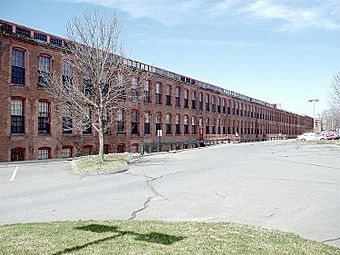Bigelow-Hartford Carpet Mills facts for kids
|
Bigelow-Hartford Carpet Mills
|
|
|
U.S. Historic district
Contributing property |
|
 |
|
| Lua error in Module:Location_map at line 420: attempt to index field 'wikibase' (a nil value). | |
| Location | Main and Pleasant Sts., Thompsonville, Connecticut |
|---|---|
| Area | 22.8 acres (9.2 ha) |
| Built | 1895 |
| Part of | Bigelow-Hartford Carpet Mills Historic District (ID94001382) |
| NRHP reference No. | 83001256 |
Quick facts for kids Significant dates |
|
| Added to NRHP | March 10, 1983 |
| Designated CP | November 25, 1994 |
The Bigelow-Hartford Carpet Mills used to be one of the biggest companies making carpets in the United States. Their factories, built in the early 1900s in Thompsonville, Connecticut, were added to the National Register of Historic Places in 1983. Different carpet companies used these buildings until the 1960s. Today, most of the old factory buildings have been turned into homes.
Contents
History of a Carpet Giant
The Bigelow-Hartford Carpet Mills complex is located in the Thompsonville area of western Enfield, Connecticut. It sits on nearly 23 acres (about 9.3 hectares) of land.
What Did the Mills Look Like?
There are seven large brick buildings in the complex. They were built between 1895 and 1928. This was when the company was at its busiest in Thompsonville. The buildings are between one and four stories tall. They have a simple, old-fashioned factory style. The biggest building is the Tapestry Mill, built in 1901. It is almost 900 feet (about 274 meters) long!
How Did It Start and Grow?
The Bigelow-Hartford Carpet Company began with a carpet-making business. Orrin Thompson started it in Thompsonville in 1828. Throughout the 1800s and early 1900s, the company grew a lot. It became the single largest maker of carpet products in the country.
The company grew by joining with other carpet makers. It made almost every type of carpet you could imagine. This helped it become the most important company in the carpet industry.
Why Did It Decline?
People started buying fewer carpets during the Great Depression. This was a time in the 1930s when many people lost their jobs and money. Because of this, the company slowly made fewer carpets through the 1950s. It finally stopped all production here in the mid-1960s.
During its busiest years, the company built many homes for its workers. These homes are mostly found north and east of the factory. They are now a big part of the Bigelow-Hartford Carpet Mills Historic District.

